You are here
- Home
- Publications and reports
- Data insights
- ICT technicians: skills opportunities and challenges (2023 update)
ICT technicians: skills opportunities and challenges (2023 update)
Summary
The Information and communication technology (ICT) sector is one of the most rapidly evolving sectors in the EU. ICT technicians, who mainly work in the ICT sector, account for around 1 per cent of all employment in the EU. These workers are important to assist the digital transformation that is currently taking place across several of Europe’s economic sectors, and they are those operating and monitoring a large part of Europe’s digital environment.
ICT technicians are tasked with providing support for the day-to-day running of computer systems, communications systems, and networks. They assist in the use of ICT systems by other people, install and maintain new programmes and equipment, and also perform various technical tasks related to telecommunications and broadcasting. Jobs within this group include ICT help desk agents, ICT security technicians, data centre operators, audio-visual and broadcasting technicians, and telecommunications engineering technicians.
Key facts
- Around 2 million people were employed as ICT technicians in 2022, which accounts for 1 per cent of the total EU employment.
- Between 2012 and 2022 ICT technician employment increased by 44 per cent. Over the same period employment across all occupations in the EU increased by almost eight per cent.
- Employment increased by more than 300 thousand workers between 2012 and 2019.
- Between 2019 and 2020, and despite the lockdowns experienced across EU economic sectors, over 100 thousand new ICT technician jobs were created and by the end of 2022 it was 300 thousand workers above the pre-Covid 19 level.
- Most ICT technicians – 52 per cent in 2021 - are employed in the ICT sector.
- More than half of ICT technicians have attained a qualification level of ISCED 3 (i.e. upper secondary education) and 4 (i.e. post-secondary non-tertiary education) in 2021. It is forecast that about 55 per cent of ICT technicians will have high-level qualifications (equivalent to post-secondary or tertiary education) by 2035.
- ICT technicians are mainly men (above 80 per cent in 2021).
- The employment of ICT technicians is projected to increase by almost one tenth between 2022 and 2035.
- By 2035 over 2.1 million people are projected to be working as ICT technicians. However, the total number of ICT technician jobs to be filled over the same period will be much larger. This is because an estimated 800 thousand people are expected to leave the occupation mainly due to retirement. Considering also the expansion demand, this means that an estimated 980 thousand job openings will need to be filled between 2022 and 2035.
- Advancements in digital technologies, their diffusion across various economic sectors, and the interplay between the digital and the green transition will drive changes in the ICT technicians’ skills required in the future.
Employment and job demand
Employment trends for ICT technicians were different from all technicians and associate professionals in the past decade. Most of the time, their employment grew much faster, and especially during the Covid-19 pandemic, ICT technicians' job trend contrasted with the general job trend for the technician and associate professional roles.
Figure 1: Year-to-year employment change for information and communications technicians (2013-2022)

Source: European Labour Force Survey. Employed persons by detailed occupation (ISCO-08 two digit level) [LFSA_EGAI2D__custom_7778289]. Own calculations.
The majority of ICT technicians (79 per cent) are engaged as information technology operations and user support technicians. These are workers who support the daily operation of communications systems, computer systems and networks and assist their users. Among other tasks, they operate and control computer equipment, monitor systems to detect equipment failure or errors, and install and repair hardware, software, or peripheral equipment.
The remaining share of ICT technicians (19 per cent) are engaged as telecommunications and broadcasting technicians. People employed in these jobs are those who control the technical functioning of image and sound recording and transmitting equipment that is used, e.g., in radio and television broadcasts and other types of telecommunication signals on land, sea or in aircraft. They also assemble and repair telecommunications systems.
Over time, the share of employment accounted for by Information technology operations and user support technicians increased while that of telecommunications and broadcasting technicians declined.
Figure 2: Employment in ICT technician jobs (in %)

Source: European Labour Force Survey. Microdata. Own calculations.
Similar to their employment structure, OJAs for information technology operations and user support technicians far exceed those for telecommunications and broadcasting technicians. Especially in ICT customer sectors (= outside of the ICT sector), ICT technicians retain an important role, while the ICT sector is increasingly dominated by specialists at the professional level.
For more details on skills demand and job openings for this occupation, please access the Cedefop’s Skills OVATE tool.
Figure 3: Online job advertisements for ICT technicians (2022, in %)
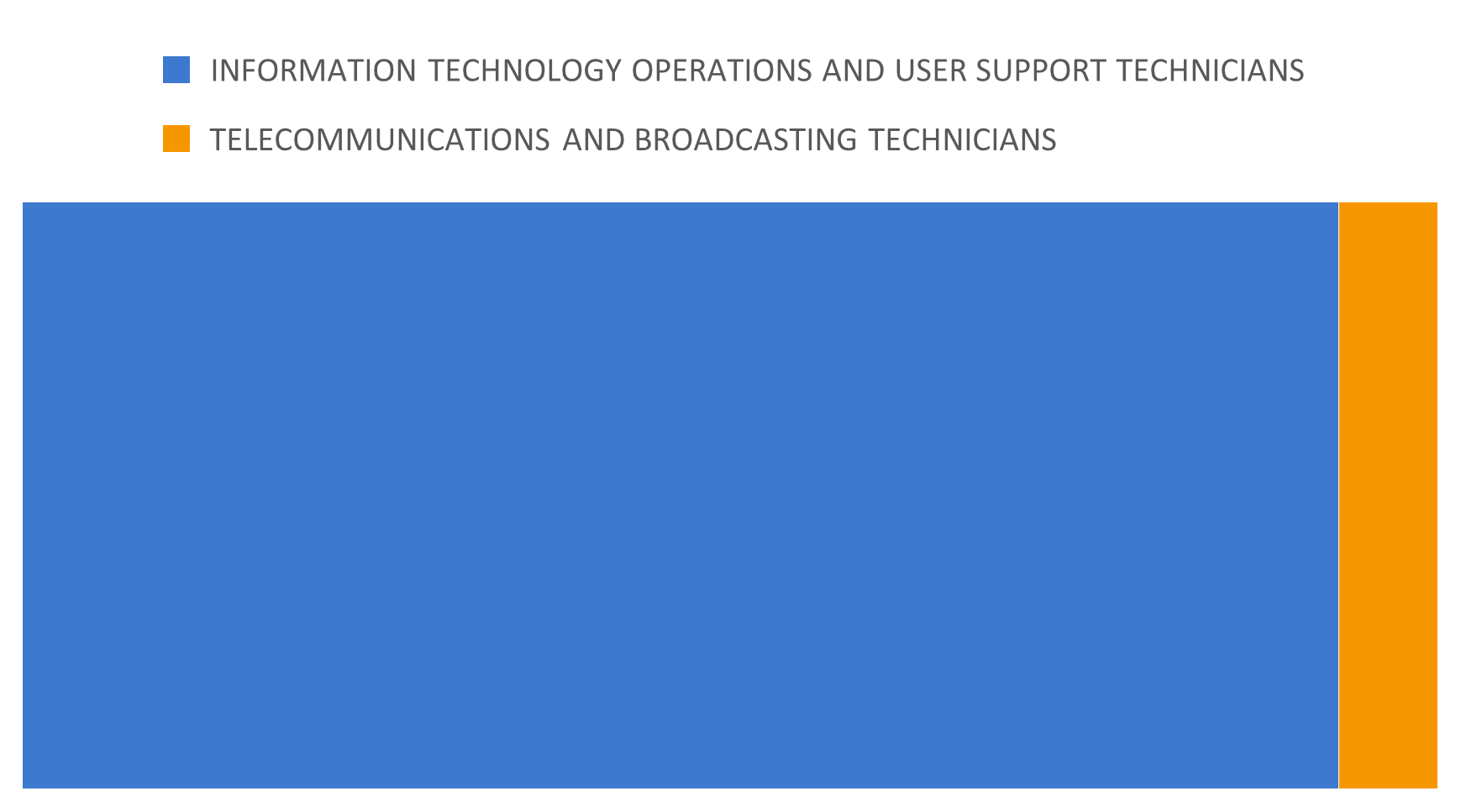
Source: Skills in Online Job Advertisements indicator based on Cedefop’s Skills OVATE. Own calculations. Note: Online job advertisements are by definition not equivalent to job vacancies. See Beręsewicz (2021) or Napierala et al. (2022).
The ICT sector employs the majority of ICT technicians (almost 50 per cent in 2016 and 2021). The manufacturing sector is the only other sector with a significant number of ICT technicians, accounting for 9 per cent in 2021.
As regards the share of ICT technicians within sectoral employment, these workers form a significant portion of the workforce in the ICT sector (14 per cent in 2021).
Figure 4: The top sectors employing ICT technicians (in %)
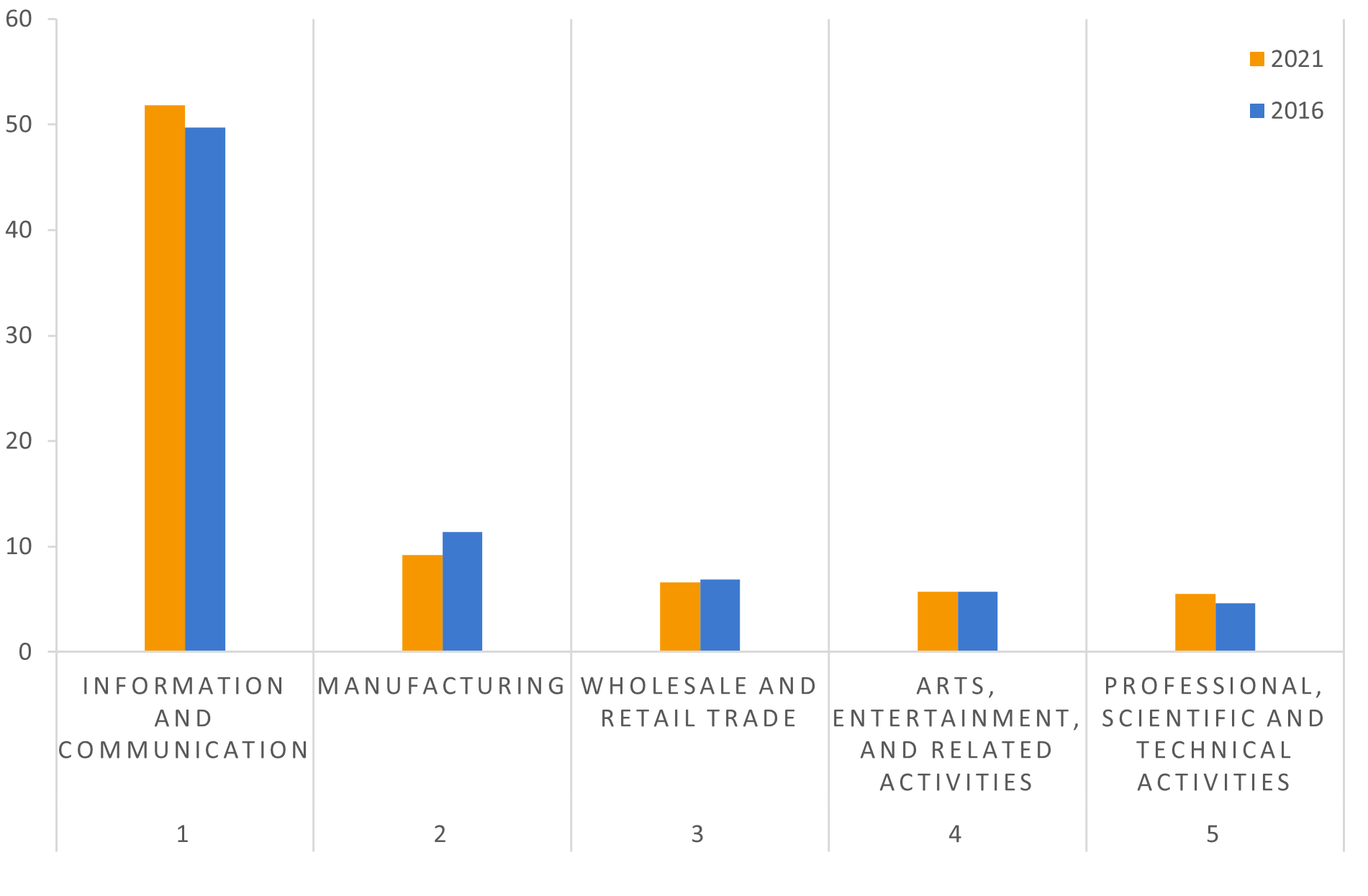
Source: European Labour Force Survey. Microdata. Own calculations.
Denmark, Spain, Czechia and Italy have the highest employment share of ICT technicians; Lithuania, Hungary and Greece have the lowest.
Figure 5: ICT technicians as a share of overall country employment (2021, in %)
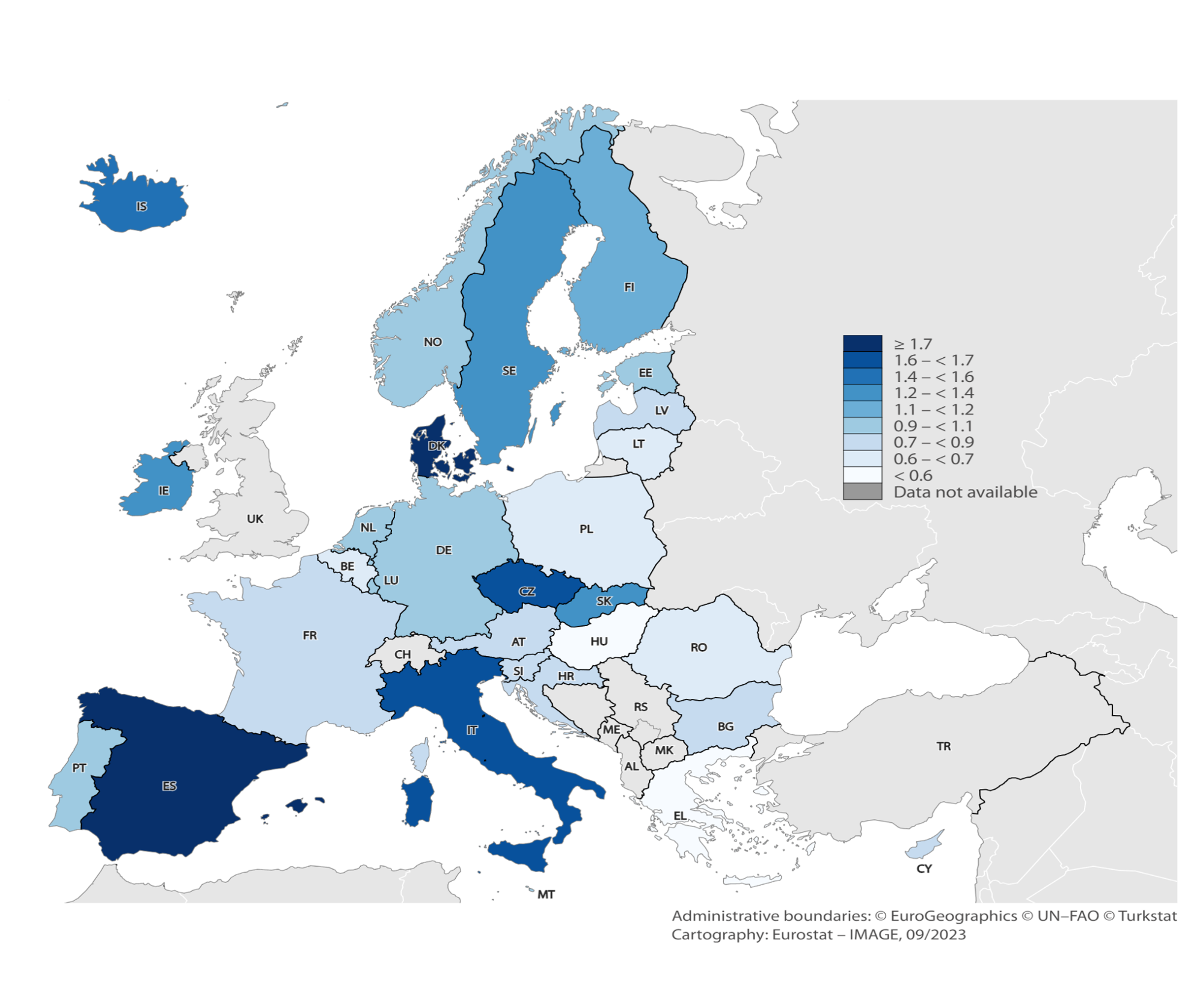
Source: European Labour Force Survey. Microdata. Own calculations.
Note: Data for CY, EE, IS, LV and LU have lower reliability because of the small sample size.
LFS data for MT are not available.
The workforce is composed mainly of men ( above 80 per cent in 2021). Like ICT professionals, ICT technicians are on average younger occupation. Only one in five ICT technicians is 50 years or older, while in most other occupations, this share goes to 30 per cent or even more.
Figure 6: ICT technicians workforce by age (in %)

Source: European Labour Force Survey. Microdata. Own calculations.
The share of ICT technicians that are employed via temporary contracts does not differ from that across all occupations, while part-time employment is a rare contract type for ICT technicians.
Figure 7: Contract and hiring trends for ICT technicians (in %)
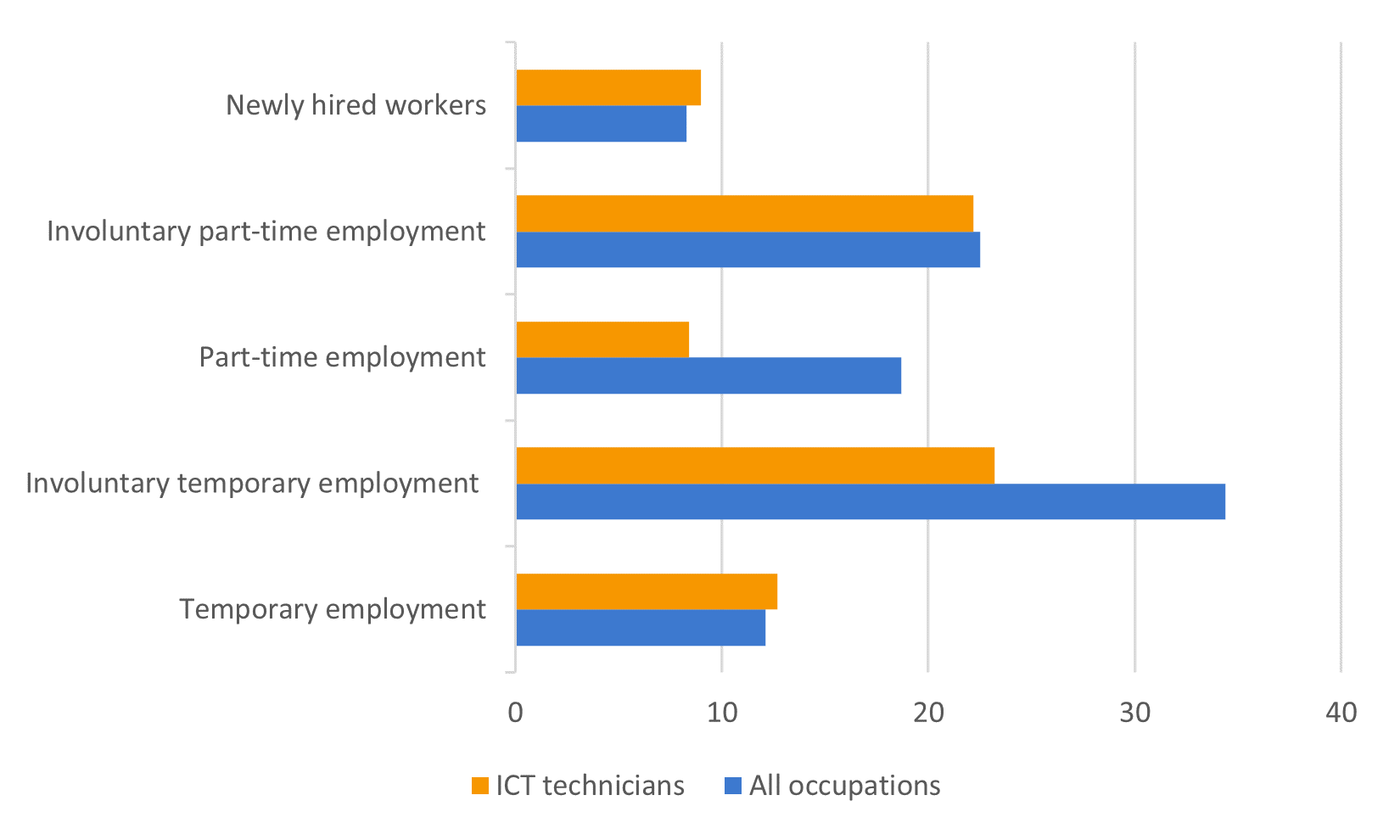
Source: European Labour Force Survey. Microdata. Own calculations.
Skill needs and future trends
While ICT technicians report only an average need for interpersonal skills, their tasks require high innovative, literacy and mathematical skills. Less than half of ICT technicians need high-level digital skills such as programming or managing databases, confirming that their domain supporting ICT tasks, such as maintenance. ICT technicians are exposed to changes requiring new skills much more often than other occupations; unlike many others though, they have much better access to necessary training.
Figure 8: Skills, training needs, and job perception of ICT technicians (in %)
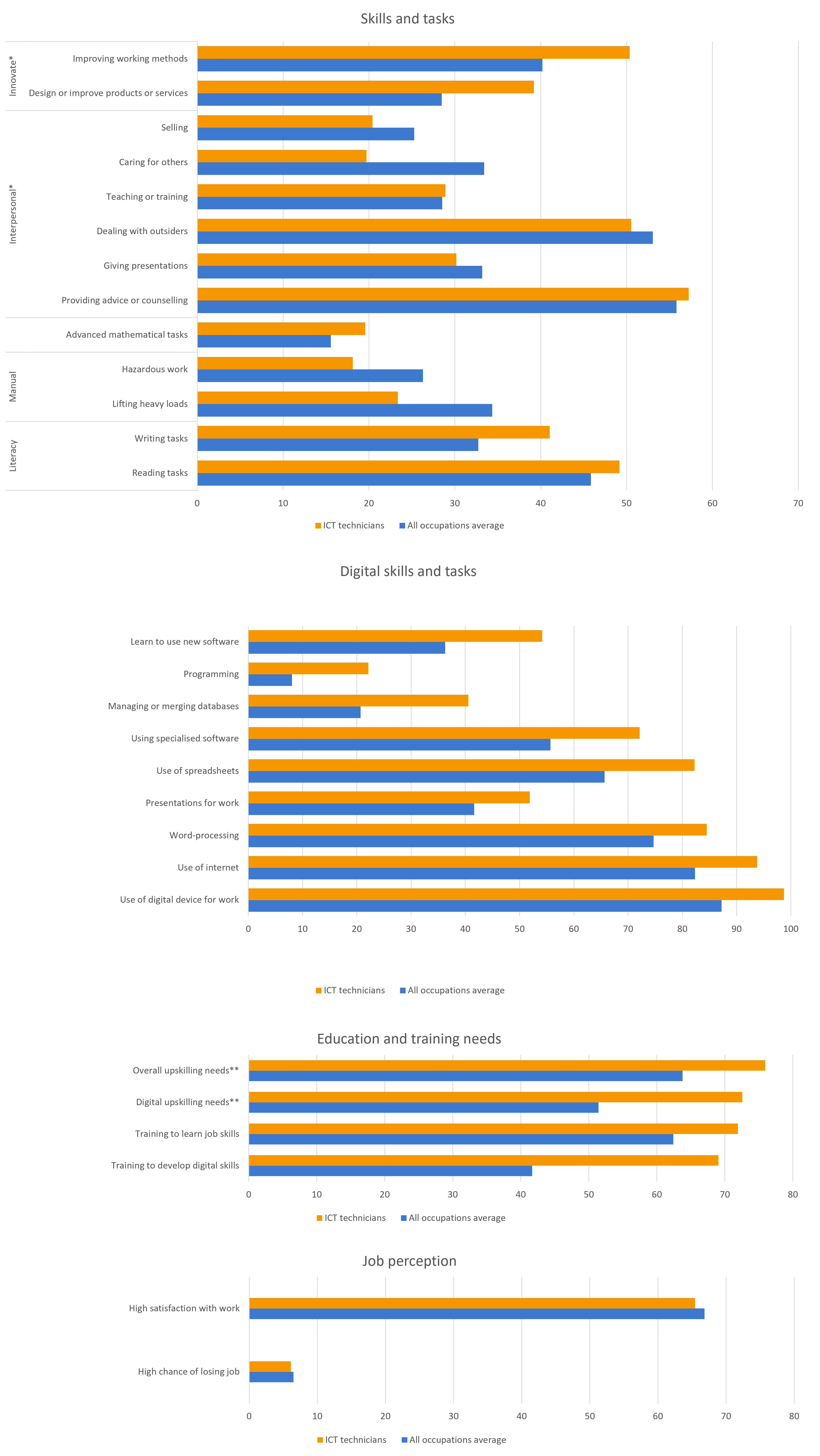
Source: European Skills and Jobs Survey. Microdata. Own calculations.
Unless stated otherwise, it is a share of people reporting that a task/skill is part of their job.
*Always or often
** Share of workers reporting these needs to a great or moderate extent.
Employment for ICT technicians is expected to increase by about 9 per cent over the period 2022 to 2035.
Employment growth will occur in most countries, but its level will vary country by country. In 13 countries grew at rates larger than 10 per cent in the past decade and it is forecast to do so in the next decade as well. Estonia, Ireland, and the Netherlands are among those with the highest past and expected future growths, while Norway and Belgium represent the opposite trend.
Figure 9: Past and expected future employment trend of ICT technicians
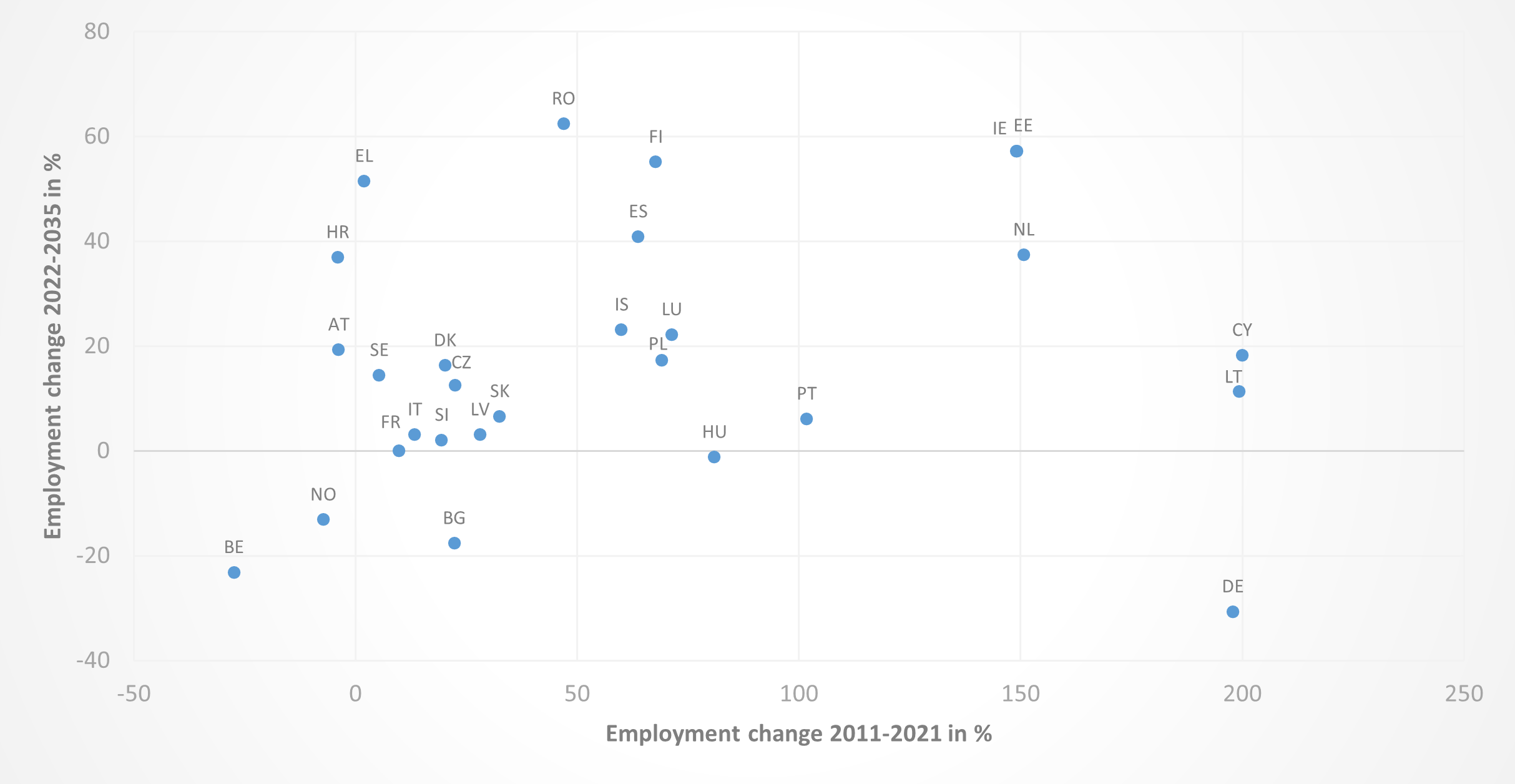
Source: European Labour Force Survey. Microdata. Cedefop Skills Forecast.
Note: Data for CY, EE, IS, LV and LU have lower reliability because of the small sample size.
LFS data for MT are not available.
New job creation is, however, not the main driver behind job demand. Most job openings are a result of people leaving them for other opportunities, or those leaving the labour market completely (retirements; parent leave and such). This replacement demand is much more substantial and in the case of the ICT technicians it is estimated at 800 thousand, thus being more than four times larger than the new job creation.
Overall, when the expansion demand is added to the replacement demand, an estimated 980 thousand job openings for ICT technicians will need to be filled between 2022 and 2035.
Figure 10: Future job openings for ICT technicians (000s)
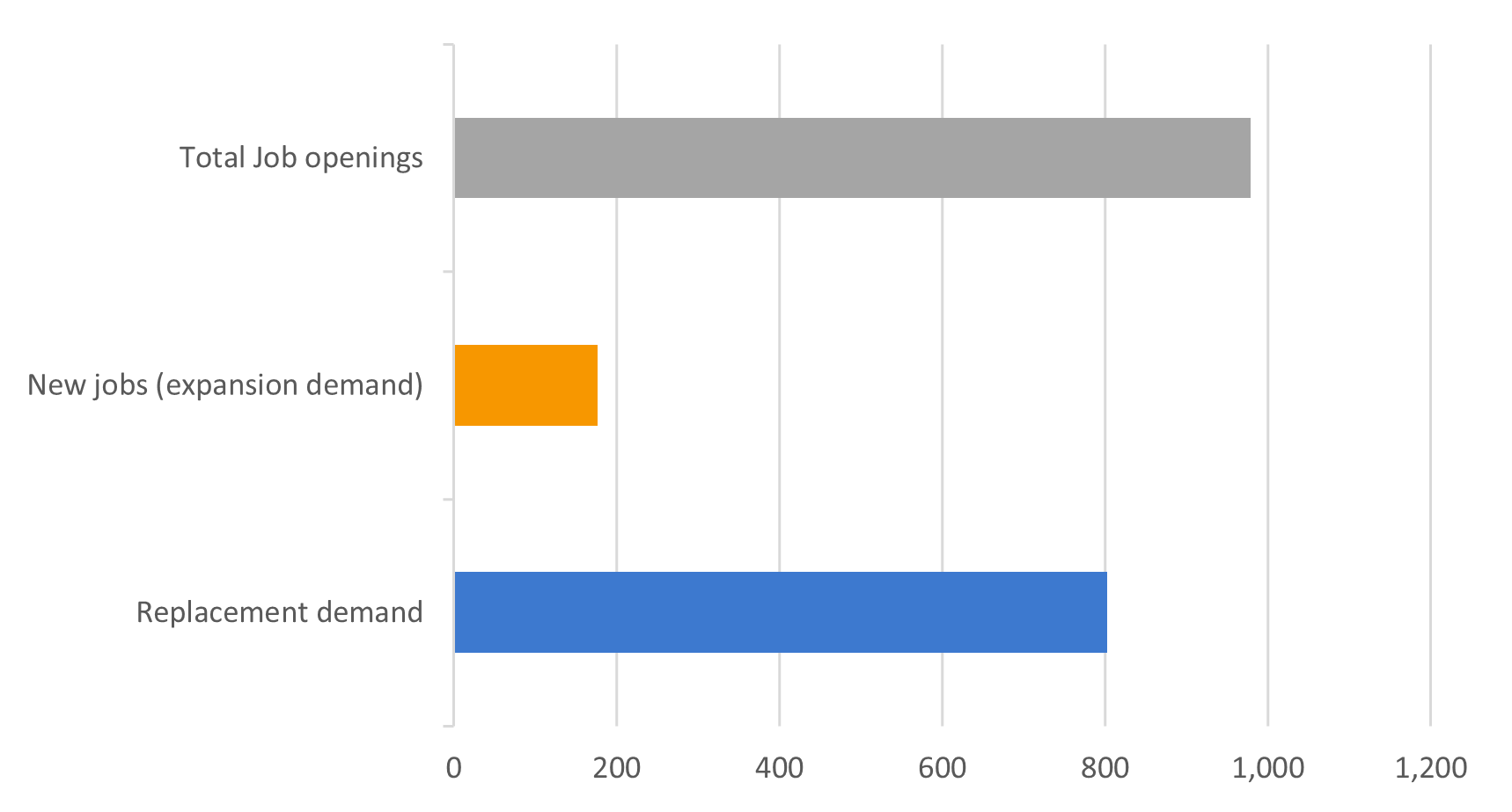
Source: Future job openings indicator based on the Cedefop Skills Forecast. Own calculations.
More than half of ICT technicians (52 per cent) held medium-level qualifications in 2021 (i.e. at ISCED levels 3 or 4). The qualification level of the occupation is projected to shift towards high-level qualifications by 2035. In particular, the share of workers with low levels of qualification (ISCED level 2 or lower) is projected to fall to 3 per cent in 2035, while the share of highly qualified workers (i.e. those qualified at ISCED level 5 and over) is projected to increase to 56 per cent.
Looking forward
Given the wide range of industries that ICT technicians can be employed in, they need to combine technical skills with sector-relevant skills as well as an understanding of the objectives and challenges of that sector. ICT is one of the fastest transforming fields. Much of that transformation owes to technological change and developments within the sector, in which a large share of ICT technicians (52 per cent, see previous sections) are occupied. A recent Needs Analysis Report conducted by the European Software Skills Alliance (ESSA) on the demand for software skills indicates that developers are likely to remain the most in-demand software skills jobs, while multi-disciplinary ‘T-shaped’ and even ‘π-shaped’ skillsets are becoming more important. This means that individuals in the ICT sector will need to have a broad range of skills complemented by one or two specialisations where they develop expert knowledge. These could include data analysis, cybersecurity, sustainability, and business relations. A similar result emerged from a recent Cedefop (2024, upcoming) report that examined the evolving skill requirements for the ICT sector. The report identifies several key factors that are likely to shape future employment demand in the ICT sector, and, to a large extent, for ICT technicians.
- Technological change does not threaten ICT technicians with redundancy but forces a change in their skillsets to accommodate technological advancements as supplementary to their workload. The gradual change of IT support from in-person service provision to increasing use of automated or AI-powered web services (including big data) can shift the tasks of ICT technicians away from reactive support and towards proactive prevention (Barlow, 2020). Web-based tools like problem-solving forums, virtual knowledge bases, and defensive programming can ease the workload of ICT technicians. These will lead to future developments like automation of IT support processes, increased attention to cybersecurity, online face-to-face support, and diversification of support channels within companies (Allinson, 2021). Future ICT technicians will thus increasingly work alongside and assist in the implementation of AI-powered technologies within their organisations. This requires technical know-how and critical thinking to ensure adaptation and user-friendliness of the constantly developing technological tools. As the routine tasks of ICT technicians are more susceptible to automation, soft skills like communication, problem-solving, resourcefulness or time management will continue to be in demand amongst employers (Perry, 2023). ICT technicians are often the first line of contact in troubleshooting technical problems. Soft skills will remain crucial in this regard to understand users’ problems and to communicate the step-by-step solutions.
- The changing nature of demand for ICT services and new regulations are two other key drivers of future skill needs in the ICT sector. The scale and nature of ICT services demand changes as businesses of more and different sectors adapt to the need to become more digital. Demand for services such as cloud computing, web sales, hosting, e-mailing, and e-accounting services are on the rise and expected to grow more in the future. ICT technicians need to implement and monitor such tailored solutions for businesses across the sectoral spectrum, from agricultural farms using precision agriculture and sensors, to manufacturing firms managing their energy use, to small retailers opting for their personal app. Although some parts of this work are automatable, adaptation to new technologies and continued digitalisation will require the support of ICT technicians across all sectors because they remain essential for the proper functioning of ICT infrastructures (OECD, 2022).
- A lot of this additional demand will relate to processes and solutions for increasing sustainability and monitoring circularity. The European Green Deal seeks to achieve green growth by decoupling economic growth from resource use. In this framework, digitalisation holds the key to facilitating a turn towards sustainable growth models. Further, in addition to facilitating digitalisation of sectors in the pursuit of sustainability, ICT technicians will also need to implement sustainability in their sector. Digital technologies account for 8-10 per cent of our energy consumption and about 2-4 per cent of greenhouse gas emissions, which indicates a need for sustainable strategies within the ICT sector. ICT technicians will be the first to do the technical work in implementing sustainable and carbon-free digitalisation. Strategies for that include the move towards renewable energy resources as well as energy efficiency (Sharma & Dash, 2022). This implies the need for upskilling amongst ICT technician workforce to understand the functioning of sustainability principles in the IT sector and beyond.
- Future ICT technicians will also need to keep up with the policy developments related to digitalisation. Working with technologies that use and analyse data in increasing volumes and complexity, requires ICT technicians to understand the principles of data protection as set in the GDPR (2016).
Ensuring sufficient skills for ICT technicians will be important for furthering digitalisation of the European economy to foster the sustainability agenda. ICT technicians have typically finished between one and three years of higher education, mostly in ICT-related studies, but also in technical sciences and generic programmes. Meeting future skills needs requires specialist training in information and communication technologies as well as acquiring soft and transversal skills through on-the-job training or short learning experiences. Ensuring quality education is key to enabling the digital success of Europe, as set in the Digital Decade Strategy (2021).
For the initial education and skills formation, future ICT technicians can acquire skills and knowledge from a variety of programming, computer science, and IT schools across Europe. For instance, CODE Berlin is a university of applied sciences that advances innovative teaching methods, project based learning, and transversal skills in its offer of courses. CODE’s BSc in Software Engineering aims to develop collaborative problem-solving skills in programming languages and database systems. During their study programme, students are given the liberty to shape their individual development – these range from Algorithms and Data Structures to Web Frontend Technologies and Blockchain & Cryptography. In the francophone world, the EPITECH (Paris Graduate School of Digital Innovation) trains IT experts in various locations. In the five year educational program students will be introduced to technical sides of ICT work, like the fundamentals of computer science, coding and programming skills, big data related technologies, software engineering etc. They will also acquire a set of transversal skills like intercultural communication, project management, and personal development.
The European Commission has brought together various strategies to promote the development of ICT skills and training future ICT-related workers. The European AI Strategy plans to address the skills gap related to artificial intelligence as a key challenge for the EU’s digital agenda. The Digital Education Action Plan 2021-2027 foresees several actions that will shape the AI-related skillset of these workers. Amongst other objectives, the action plan supports increasing the participation of VET students and teaching staff in traineeships related to digital areas alongside university students; increasing female participation in AI-related training activities; and promoting the application of AI in compulsory education. An example of engaging more women in ICT-related jobs is the WOMEN4IT project, which addresses the gender gap in digital skills. As of 2020, the share of women in this occupation was only 19.2 per cent. The ambition of this multistakeholder project is to develop digital competences of young women at risk of labour market exclusion. WOMEN4IT does it through awareness raising and promotion of innovative partnerships/solutions for women to be included in the digital agenda.
The European digital decade strategy seeks to increase the number of ICT workforce to 20 million in 2030. The DigComp 2.2 (Digital Competence Framework for Citizens) maps the digital skills and competences that are relevant for the future labour market. The latest version groups digital competences under information literacy, communication/collaboration, digital content creation, safety, and problem-solving (Vuorikari et al, 2022). There are several skills alliances that seek to forward a progressive skills agenda in several digital fields.
ESSA (European Software Skills Alliance) connects stakeholders to design future-looking skills development programs in software development. The alliance leverages the European Competence Framework (e-CF) to identify relevant e-competences and professional profiles in software development. Meanwhile, the Digital SkillUp project offers online training courses on emerging technologies from beginner to advanced professional levels.
Additionally, professionals in ICT can re- and upskill through short-term learning experiences, such as micro-credentials. Micro-credentials are certified learning experiences, which allow for the students to upgrade their skills, knowledge, and competences on a particular topic. They are designed to be flexible in availability so that people can combine the workload with their professional and personal lives. Further EU-wide information on such courses is available on Digital Skills and Jobs Platform. This online resource collects training opportunities on digital skills and emerging technologies.
For example, the EIT Digital Summer School AI4Green Business Lab is a project-based training course, presenting the participants with real-world problems related to the implementation European Green Deal. The Blockchain Skills for ICT professionals (BLISS) introduces various pathways to skills enhancement in this emerging technology, covering topics like legal frameworks, (dis)advantages of blockchain technologies, its business applications, and critical analysis of blockchain applicability.
How to cite this publication:
Cedefop (2023). ICT technicians: skills opportunities and challenges. Skills intelligence data insight.
Further reading
Allinson, M. (2021). ‘A Look at the Past, Present, and Future of IT Support’. Robotics and Automation News, published 12 July 2021
Beręsewicz, M. and Pater, R. (2021). Inferring job vacancies from online job advertisements, Luxembourg: Publications Office, 2021. https://ec.europa.eu/eurostat/web/products-statistical-working-papers/-/ks-tc-20-008
Barlow, A. (2020). ‘The Future of Technology Support’, in Forbes, published 3rd September 2020
Cedefop (2023a). Going digital means skilling for digital: using big data to track emerging digital skill needs. Luxembourg: Publications Office. http://data.europa.eu/doi/10.2801/772175
Cedefop (2023b). Skills in transition: the way to 2035.Luxembourg: Publications Office. http://data.europa.eu/doi/10.2801/438491
European Commission (2019). The European Green Deal. COM(2019) 640
European Commision (2020). Digital Education Action Plan 2021-2027. COM(2020) 624
European Commission (2021a). Fostering a European Approach to Artificial Intelligence. COM(2021) 205
European Commission (2021b). 2030 Digital Compass: the European way for the Digital Decade. COM(2021) 118 final
European Software Skills Alliance (ESSA) (2021). Europe’s Most Needed Software Roles and Skills. Needs Analysis Report.
Napierala, J.; Kvetan, V. and Branka, J. (2022). Assessing the representativeness of online job advertisements. Luxembourg: Publications Office. Cedefop working paper, No 17. http://data.europa.eu/doi/10.2801/807500
OECD (2022). ‘Skills for the Digital Transition: Assessing Recent Trends Using Big Data’, OECD Publishing: Paris
Perry, C. (2023). ‘The Tech Soft Skills You Need to Succeed’. Forbes Advisor, published 16 February 2023
Regulation (EU) 2016/679. General Data Protection Regulation. Official Journal of the European Union. L119/1
Sharma, P. & Dash, B. (2022). ‘The Digital Carbon Footprint: Threat to an Environmentally Sustainable Future’, in International Journal of Computer Science and Information Technology, Vol. 14(3)
Vuorikari, R., Kluzer, S., Punie, Y. (2022). ‘The Digital Competence Framework for Citizens – With new examples of knowledge, skills and attitudes’. Publications Office of the EU: Luxembourg
Data insights details
Table of contents
Page 1
SummaryPage 2
Employment and job demandPage 3
Skill needs and future trendsPage 4
Looking forwardPage 5
Further reading
